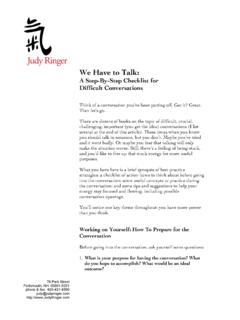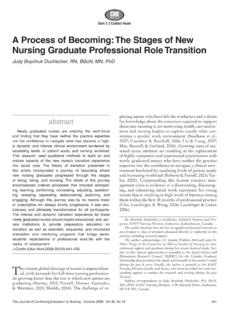Transcription of Judy Cassab: Essentially Australian - MRAG
1 judy Cassab: Essentially Australian A Maitland Regional Art Gallery Touring Exhibition EDUCATION RESOURCE judy Cassab: Essentially Australian 1 A Maitland Regional Art Gallery Touring Exhibition judy Cassab: Essentially Australian Budapest, 24 March 1947 The way I can paint still lifes, five hundred others can too. But only two perhaps can paint a portrait like I do. I argued against easy success, and at which time in my life should I think positively if not when I m young?
2 I Introduction This education resource has been produced by the Maitland Regional Art Gallery (MRAG), as supporting material for the tour of the exhibition judy Cassab: Essentially Australian . The exhibition was curated by MRAG Cultural Director, Joseph Eisenberg and Curatorial Assistant, Tobias Spitzer. This kit aims to offer an insight into judy Cassab s engaging and challenging practice as an Australian female artist. The complexity of her work is explored through a range of material, including a book by Lou Klepac, catalogue, online resources, and the artist s own published diaries, with discussion and activities for during and after the gallery visit.
3 This resource is written for use by teachers and students of school and tertiary groups of all levels, and as a general guide for those visiting the exhibition in mixed groups. This material will also be useful for museum education staff, as well as the general museum visitor. Ways to use this kit This kit can be used in a range of ways by education groups, and for individual study or research. Use the images, activities and ideas to assist pre-visit preparation, as a guide during the gallery visit and to develop post-visit activities and assignments.
4 Teachers are advised to adapt these activities to suit their students needs or integrate sections of the kit into existing classroom units of study. The kit is specific to the exhibition visit to help students and teachers engage with the actual works of art, but is also intended to be used after the exhibition has closed extending the life of the exhibition, and becoming a general classroom resource on the artist. Education Unit Maitland Regional Art Gallery Front cover: judy Cassab, Self Portrait: Divided Decision, 1996, Acrylic and oil on canvas, 92 x 127 cm judy Cassab: Essentially Australian 2 A Maitland Regional Art Gallery Touring Exhibition judy Cassab Born: 15 August 1920 Vienna, Austria judy Cassab is one of Australia's well-known portrait artists and winner of many prestigious art awards including the Archibald Prize on two occasions.
5 In Australia, she quickly gained a reputation for her portrait painting, regularly accepting commissions. In 1969 judy was appointed as a Commander of the Order of the British Empire (CBE) for her service to the visual arts. In 1988 she was also appointed as an Officer of the Order of Australia (AO). Following the publication of her diaries in 1995, The University of Sydney conferred on her the honorary degree of Doctor of Letters (Hon. PhD). Also for her diaries she won the Nita B. Kibble Award for women writers in 1996. --- judy Cassab began to paint at 12 years of age.
6 At this time she also began to keep a diary, a practice, which to this day she still maintains. I had always thought that I expressed my thoughts with a brush. I never knew that I could write. Writing, I thought, is just a habit like washing my teeth; I could not go to bed without doing it. I do not feel anxious about my paintings. I can always paint others. It is different with the diaries. I lost the first 11 years of my diaries when they were left in my childhood home in Beregsz sz and perished during the war. I lost everything else I had there.
7 But objects, even beautiful objects are replaceable. One can never recapture a 12-year-old judy Cassab was born Judit Kaszab in Vienna, Austria, in 1920, to Hungarian parents. In 1929 the Kaszab family returned to Hungary where her parents separated and judy spent the rest of her childhood years living in her grandmother's house. In 1939 she married Jancsi Kampfner, after making him promise that their marriage would not stand in the way of her being a painter. Jancsi kept the promise throughout their marriage and was a constant source of encouragement to judy .
8 The couples early married life was surrounded by the horrors of World War II. Jancsi was sent to a forced slave labour camp and was one of the few to survive. It was during this time that Jancsi encouraged judy to flee to Budapest to study painting. Between 1939 and 1949 she studied art in Prague and at the Budapest Academy. With her studies interrupted by Nazi occupation, judy survived by going underground and hiding her Jewish identity. In her published diaries she wrote of the period that, it was the first time in my life that I was not a girl, not a woman, not a human being, but a Jew'.
9 Iii After many years of hardship and loss, in 1951, judy , Jancsi and their two Budapest-born sons, were able to migrate to Australia. Since her first solo exhibition at the Macquarie Galleries in Sydney in 1953, judy Cassab has held well over fifty solo exhibitions throughout Australia as well as in Paris, London and Budapest. judy Cassab: Essentially Australian 3 A Maitland Regional Art Gallery Touring Exhibition As a teenager judy Cassab showed some of her work to one of her first teachers, hoping to receive praise for her proficient technique.
10 The teacher shattered her confidence by telling her that it was hopeless. He explained to the young artist that there was more to art than technical skill and in order to achieve it she would need to restrain her obvious natural abilities rather than show them off. He instructed her to draw with her other hand, with her eyes closed, in order to subdue her facility and to enable her to find the means to paint a true picture. My Grandmother, 1932 charcoal, x cm judy Cassab: Essentially Australian 4 A Maitland Regional Art Gallery Touring Exhibition The portrait Budapest, 15 February 1946 I don t dare tell this to anyone, but I feel one day I am going to paint better portraits than anyone.








